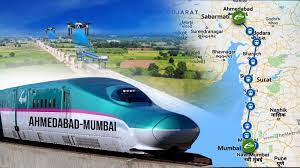


In the realm of transportation engineering, India's ambitious strides are making headlines with the Mumbai-Ahmedabad High-Speed Rail (MAHSR) project. Pioneering a groundbreaking venture into underwater rail infrastructure, this project spans 7 kilometers between Shilphata and BKC, utilizing state-of-the-art techniques such as the Tunnel Boring Machine (TBM) and New Austrian Tunneling Method (NATM). Spearheaded by the Ministry of Railways, Communications, and Electronics & Information Technology, this visionary endeavor promises to revolutionize connectivity across the high-growth states of Gujarat and Maharashtra.
Unveiling Cutting-Edge Techniques
The utilization of advanced tunneling methodologies underscores the project's commitment to innovation. With a staggering 13.6-meter cutter head diameter, TBMs employed in the construction are a testament to engineering excellence. Additionally, the NATM method is deployed for a segment of the tunnel, showcasing versatility in approach. These techniques not only ensure efficient construction but also elevate India's standing in the realm of transportation infrastructure.
Milestones and Progress
As of the latest update, significant milestones have been achieved, with substantial progress across various fronts. The completion of 290.64 km of pier foundation, 267.48 km of pier construction, 150.97 km of girder casting, and 119 km of girder launching marks a testament to the project's momentum. However, the timeline and final cost remain contingent upon the awarding of all contract packages, highlighting the dynamic nature of such monumental endeavors.
Strategic Locations and Structural Ingenuity
Strategically positioned shafts and portals play a pivotal role in facilitating construction. From Mumbai HSR Station to Sawli near Ghansoli, each location is meticulously planned to optimize efficiency and ensure seamless execution. The depths ranging from 25 to 57 meters below ground level, with the deepest point plunging to 114 meters beneath the Parsik hill near Shilphata, underscore the structural complexity of the project.
Enhancing Connectivity and Economic Viability
The MAHSR project is more than just a feat of engineering; it is a catalyst for economic growth and regional connectivity. By linking key business hubs such as Mumbai, Surat, Vadodara, and Ahmedabad, the project is poised to unlock new avenues for trade, commerce, and tourism. A feasibility study conducted by the Japanese International Cooperation Agency (JICA) projected an Economic Internal Rate of Return (EIRR) of 11.8%, highlighting the project's potential to drive economic prosperity.

Conclusion
In conclusion, the Mumbai-Ahmedabad High-Speed Rail project represents a paradigm shift in India's infrastructure landscape. With its innovative approach, strategic execution, and economic viability, it embodies the nation's commitment to harnessing technology for progress. As construction progresses and milestones are surpassed, the MAHSR project stands as a testament to India's aspirations for a brighter, more connected future.
News Articles
Other Real Estate News Articles